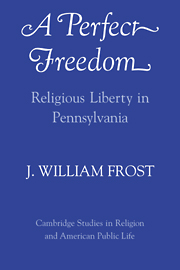Book contents
- Frontmatter
- Contents
- Acknowledgments
- Preface to This Paperback Reissue
- Introduction: The Pennsylvania Traditions of Religious Liberty
- I The Creation of Religious Liberty in Early Pennsylvania
- II Pacifism and Religious Liberty
- III The Clergy and Religious Liberty
- IV Religious Liberty in the Revolution
- V Religious Liberty and the Republic
- VI Politicians Debate Religious Liberty
- VII The Churches and Religious Liberty
- VIII The Legal Implications of Religious Liberty
- IX Religious Liberty and the Catholic and Jewish Minorities
- Epilogue: The Dismantling
- Notes
- Bibliography
- Index
VIII - The Legal Implications of Religious Liberty
- Frontmatter
- Contents
- Acknowledgments
- Preface to This Paperback Reissue
- Introduction: The Pennsylvania Traditions of Religious Liberty
- I The Creation of Religious Liberty in Early Pennsylvania
- II Pacifism and Religious Liberty
- III The Clergy and Religious Liberty
- IV Religious Liberty in the Revolution
- V Religious Liberty and the Republic
- VI Politicians Debate Religious Liberty
- VII The Churches and Religious Liberty
- VIII The Legal Implications of Religious Liberty
- IX Religious Liberty and the Catholic and Jewish Minorities
- Epilogue: The Dismantling
- Notes
- Bibliography
- Index
Summary
The rhetoric of religious liberty had to be translated into law and jurisprudence to be meaningful in practice. The state and the courts sought for a definition that would show a fostering benevolent neutrality, treat all religious institutions equally, preserve the religious fabric of the Commonwealth, and protect individual and group freedom of conscience. Court cases illustrate very clearly the dilemmas Pennsylvanians encountered with their contrary, if not contradictory, attitudes toward religious freedom and separation of church and state. An analysis of cases of property rights, blasphemy, and the Sabbath will show how the courts protected and fostered religion by defining the churches as corporations advocating morality. This legal fiction enabled the Commonwealth to have no religion and to be religious at the same time.
In 1731 the Pennsylvania Assembly passed an act enabling “Religious Societies of Protestants Within This Province” to purchase land and hold property. A later act allowed the religious societies to specify an association or creed whose adherents would retain control of the property. Some colonial Pennsylvania churches sought charters of incorporation from the proprietors, but many more had trustees who controlled the property. The sectarian groups (Quakers, Mennonites) in colonial Pennsylvania did not seek charters and never used lotteries to finance the erection of structures. Before 1776 Reformed, Lutheran, Presbyterian, and Anglican churches had received charters along with the college, a hospital, learned societies, and a religiously based insurance company.
- Type
- Chapter
- Information
- A Perfect FreedomReligious Liberty in Pennsylvania, pp. 124 - 143Publisher: Cambridge University PressPrint publication year: 1990



